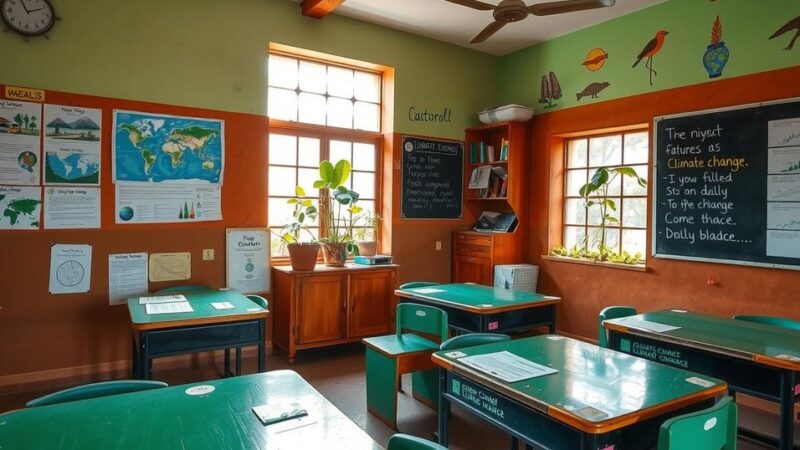Yemen faces a critical juncture marked by conflict and climate change, which exacerbate poverty and food insecurity. The World Bank’s CCDR stresses immediate climate-responsive investments needed in water and agriculture. Projections warn of significant GDP losses without action, while opportunities exist for building resilience through strategic initiatives. Emphasizing the roles of peace and private sector involvement, the report lays out a comprehensive framework for Yemen’s sustainable recovery.
Yemen is currently grappling with an unprecedented intersection of crises, encompassing conflict, climate change, and poverty. The newly released Yemen Country Climate and Development Report (CCDR) by the World Bank Group underscores the urgent need for climate-responsive investments to address imperatives in water, agriculture, and disaster risk management, particularly in the context of the fragile conditions prevailing in the nation. The report highlights the increasing risks posed by climate change, including rising temperatures and erratic rainfall patterns, which exacerbate existing vulnerabilities such as water scarcity and food insecurity.
The alarming reality is that approximately half of the Yemeni population is exposed to at least one climate hazard, including extreme heat, flooding, or drought, with potentially severe implications for economic stability. Projections indicate that without immediate intervention, Yemen’s GDP may decline by an average of 3.9% by the year 2040 under adverse climate scenarios, driven largely by decreased agricultural productivity and damage to infrastructure.
Despite the severity of these challenges, the CCDR outlines potential pathways for resilience building, particularly through targeted investments in critical areas such as water management and sustainable agricultural practices. These initiatives could yield notable productivity increases, up to 13.5%, in crop production by the years 2041 to 2050 if optimistic climate scenarios prevail. Yet, the fisheries sector remains precarious, with expectations of losses up to 23% by mid-century due to the adverse effects of rising sea temperatures.
For Yemen, immediate and decisive action on climate resilience is essential. Stephane Guimbert, the World Bank Country Director for Egypt, Yemen, and Djibouti stated, “Yemen is facing an unprecedented convergence of crises — conflict, climate change, and poverty. Immediate and decisive action on climate resilience is a matter of survival for millions of Yemenis. By investing in water security, climate-smart agriculture, and renewable energy, Yemen can safeguard human capital, build resilience and lay the foundations for a path to sustainable recovery.”
The report emphasizes that peacebuilding efforts and dedicated international support are prerequisites for successful development scenarios in Yemen. While humanitarian aid can alleviate immediate suffering and enhance resilience against climate shocks, achieving sustainable peace is paramount to securing the long-term investments necessary for climate adaptation.
With disaster risk management being a focal point due to an increase in flood events, especially in urban settings, it is particularly crucial to implement adaptive measures to protect vulnerable communities. The report estimates that climate-related health challenges could incur over US$5 billion in excess health costs by 2050, exacerbating pressures on Yemen’s fragile healthcare systems. It further advocates integrating climate resilience strategies into public health planning with a specific focus on vulnerable demographics such as women and children.
Yemen’s vast potential for renewable energy resources presents an opportunity to mitigate reliance on fossil fuels while fostering a more resilient energy grid. This adaptation is crucial for sustaining essential services, including healthcare, water supply, and food distribution, especially in conflict-impacted regions.
According to Khawaja Aftab Ahmed, IFC’s Regional Director for the Middle East, “The private sector has a critical role to play in addressing Yemen’s pressing development challenges. Harnessing its potential through innovative financing mechanisms and guarantee instruments and creating a conducive investment climate can help mobilize the climate-focused funding the country urgently needs to build a greener and more resilient future.”
In summary, the CCDR presents a pathway for flexible and risk-informed decision-making in climate actions tailored to Yemen’s volatile political context. A scenario-based approach allows for differentiated climate investments based on Yemen’s trajectory toward peace or escalating conflict. Under a “Peace and Prosperity” scenario, strategic adaptation efforts could result in significant socio-economic progression.
The Yemen Country Climate and Development Report (CCDR) was recently published by the World Bank Group, focusing on the intertwined crises of climate change, conflict, and poverty that Yemen faces. The report provides an analysis of the country’s vulnerability to climate-related risks and emphasizes the critical need for investments that address urgent issues in agriculture, water management, and disaster risk management. This initiative is set against a backdrop of a decade-long conflict and growing climate challenges. The report seeks to inform stakeholders, including governmental bodies and the private sector, on necessary actions to foster resilience and sustainable growth in a challenging environment.
The World Bank Group’s Yemen Country Climate and Development Report highlights the urgent need for resilience-building investments amidst Yemen’s dual crises of climate change and ongoing conflict. With strategic interventions aimed at water and agriculture, coupled with peacebuilding efforts, so long as international support is secured, it is possible to foster a sustainable future for Yemen. Embracing renewable energy and private sector involvement will further enhance Yemen’s capacity to navigate these challenges effectively, promising a potential path toward recovery and growth.
Original Source: www.worldbank.org






